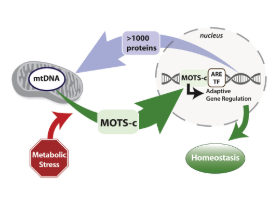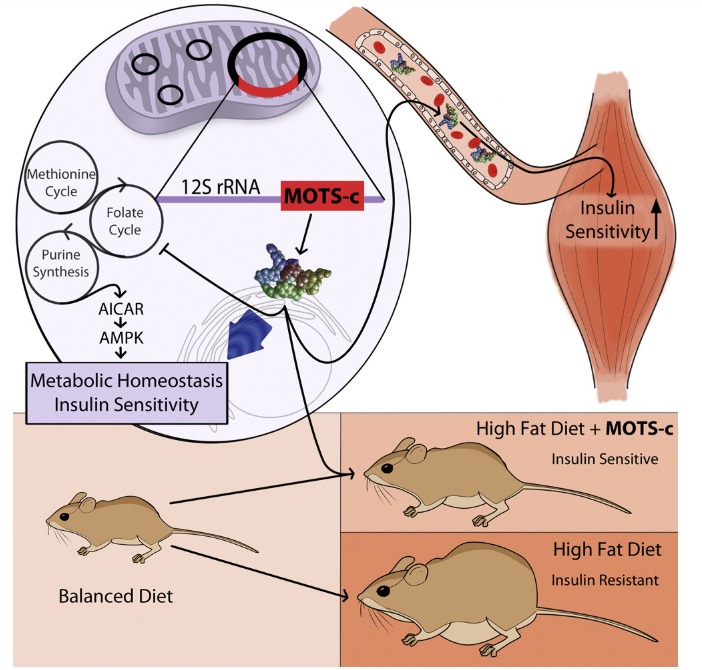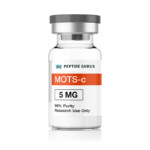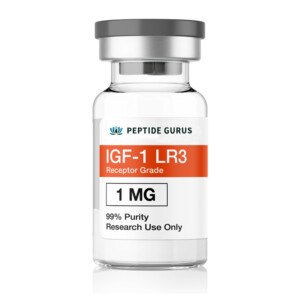Gratis (1) 30 ml de agua bacteriostática
con pedidos calificados sobre $500 Dólar estadounidense.
(excluye productos en cápsulas, péptidos cosméticos, códigos promocionales y envío)
The Mitochondrial-Derived Peptide MOTS-c promotes metabolic homeostasis and longevity, improves exercise capacity, reduces obesity, insulin resistance and other disease processes such as osteoporosis .
Uso del producto: Este PRODUCTO ESTÁ DISEÑADO ÚNICAMENTE COMO QUÍMICO DE INVESTIGACIÓN. Esta designación permite el uso de productos químicos de investigación estrictamente para pruebas in vitro y experimentación de laboratorio únicamente.. Toda la información del producto disponible en este sitio web es solo para fines educativos.. La introducción corporal de cualquier tipo en personas o animales está estrictamente prohibida por la ley.. Este producto sólo debe ser manipulado por personal autorizado., profesionales cualificados. Este producto no es un medicamento., alimento, o cosmético y no puede estar mal etiquetado, mal utilizado o mal etiquetado como droga, comida o cosmética.
MOTS-c Overview
MOTS-c Structure

MOTS-C Structure, De BQUB17-JHolguera – Trabajo propio, CC BY-SA 4.0
Fuente: Wikipedia
Secuencia: Met-Arg-Trp-Gln-Glu-Met-Gly-Tyr-Ile-Phe-Tyr-Pro-Arg-Lys-Leu-Arg
Fórmula molecular: C101h152norte28oh22S2
Peso molecular: 2174.64 g/mol
PubChem SID: 255386757
Número CAS: 1627580-64-6
Sinónimos: Mitochondrial open reading frame of the 12S rRNA-c, MT-RNR1
MOTS-c Research
Muscle Metabolism
Research in mice indicates the MOTS-c can reverse age-dependent insulin resistance in muscles, thereby improving muscle uptake of glucose. It does this by improving skeletal muscle response to AMPK activation, which in turn increases the expression of glucose transporters[1]. It is important to note that this activation is independent of the insulin pathway and thus offers an alternative means of boosting glucose uptake by muscles when insulin is ineffective or in insufficient quantity. The net result is improved muscle function, enhanced muscle growth, and decreased functional insulin resistance.
Fat Metabolism
Research in mice has shown that low levels of estrogen lead to increased fat mass and dysfunction of normal adipose tissue. This scenario increases the risk of developing insulin resistance and, subsequently, the risk of developing diabetes. Supplementing mice with MOTS-c, sin embargo, increases brown fat function and reduces the accumulation of adipose tissue. It also appears that the peptide prevents adipose dysfunction and the adipose inflammation that typically precedes insulin resistance[2].
It appears that at least part of the influence that MOTS-c has on fat metabolism is mediated through activation of the AMPK pathway. This well-defined pathway is turned on when cellular energy levels are low and it drives the uptake of both glucose and fatty acids by cells for metabolism. It is also the pathway that is activated in ketogenic diets, like the Atkin’s diet, which promote fat metabolism while protecting lean body mass. MOTS-c targets the methionine-folate cycle, increases AICAR levels, and activates AMPK.
New research suggests that MOTS-c can actually leave the mitochondria and make its way to the nucleus where the peptide can affect nuclear gene expression. Following metabolic stress, MOTS-c has been shown to regulate nuclear genes involved in glucose restriction and antioxidant responses[3].

MOTS-c has effects in both the mitochondria and the nucleus.
Fuente: Cell Metabolism
Evidence from mice indicates that MOTS-c, particularly in the setting of obesity, is an important regulator of sphingolipid, monoacylglycerol, and dicarboxylate metabolism. By down-regulating these pathways and increasing beta-oxidation, MOTS-c appears to prevent fat accumulation[4]. Some of these effects are almost certainly mediated via MOTS-c action in the nucleus. Research on MOTS-c has led to a new hypothesis about fat deposition and insulin resistance that is gaining traction in the scientific community and may offer a new means of intervening in the pathophysiology of obesity and diabetes. It appears that dysregulation of fat metabolism in mitochondria may result in a lack of fat oxidation. This leads to higher levels of circulating fat and thus forces the body to boost insulin levels in an effort to clear lipids from the bloodstream. The consequence of this action is increased fat deposition and a homeostatic change in the body as it adapts to (and becomes resistant to) chronically higher levels of insulin[5].

MOTS-c supplementation in rats prevents mitochondrial dysfunction and prevents the accumulation of fat even in the setting of a high-fat diet.
Fuente: Cell Metabolism
Insulin Sensitivity
Research measuring MOTS-c levels in insulin sensitive and insulin resistant individuals has shown that the protein is associated with insulin sensitivity only in lean individuals. En otras palabras, MOTS-c appears to be important in the pathogenesis of insulin insensitivity, but not in the maintenance of the condition[6]. Scientists speculate that the peptide maybe a useful means of monitoring pre-diabetic lean individuals and that changes in MOTS-c levels could act as an early warning sign of potential insulin insensitivity. Supplementation with MOTS-c in this setting could help to stave off insulin resistance and thus the development of diabetes. Research in mice thus far has been promising, but more work is needed to understand the full impact of MOTS-c on insulin regulation.
Osteoporosis
MOTS-c appears to play a role in the synthesis of type I collagen by osteoblasts in bone. Research in osteoblast cell lines shows that MOTS-c regulates the TGF-beta/SMAD pathway responsible for the health and survival of osteoblasts. By promoting osteoblast survival, MOTS-c helps to improve type I collagen synthesis and therefore the strength and integrity of bone[7].
Additional research in osteoporosis has revealed that MOTS-c promotes the differentiation of bone marrow stem cells via the same TGF-beta/SMAD pathway. In the study, this directly led to increased osteogenesis (formation of new bone)[8]. De este modo, not only does MOTS-c protect osteoblasts and promote their survival, it promotes their development from stem cells as well.
Longevity
Research on MOTS-c has identified a specific change in the peptide that is associated with longevity in certain human populations, such as the Japanese. The change in the MOTS-c gene, in this case, leads to the substitution of a glutamate residue for the lysine that is normally found in position 14 of the protein. It is not clear how this change affects the functional aspects of the protein, but that it does is almost certain as glutamate has radically different properties than lysine and thus would change both the structure and the function of the MOTS-c gene. More research is required to understand how this change affects function, but it is found exclusively in people with Northeast Asian ancestry and is thought to play a role in the exceptional longevity seen in this population[9].
Según la Dra.. Changhan David Lee, a researcher at the School of Gerontology at USC Leonard Davis, mitchondrial biology holds the keep to extending both lifespan and healthspan in humans. The mitochondria, being the single most important metabolic organelle, is “strongly implicated in aging and age-related diseases.” Until now, dietary restriction offered the only reliable means of affecting mitochondrial function and thus longevity. Peptides like MOTS-c, sin embargo, may make it possible to directly impact mitochondrial function in a more profound way.
Heart Health
Research measuring MOTS-c levels in humans undergoing coronary angiography has revealed that patients with lower levels of MOTS-c in the blood have higher levels of endothelial cell dysfunction. Endothelial cells line the inside of blood vessels and are integral to the regulation of blood pressure, coagulación de la sangre, and plaque formation. Additional research in rats suggests that while MOTS-c does not directly affect blood vessel responsiveness, it does sensitize endothelial cells to the effects of other signaling molecules, like acetylcholine. Supplementing rats with MOTS-c has been shown to improve endothelial function and improve microvascular and epicardial blood vessel function[10].
MOTS-c is not alone among mitochondria-derived peptides (MDPs) in affecting heart health. Research suggests that at least three MDPs play roles in protecting cardiac cells against stress and inflammation. There is good reason to believe that MDP dysregulation is also an important factor in the development of cardiovascular disease. The peptides may even be important factors in reperfusion injury and, as pointed out above, in endothelial function[11].
MOTS-c exhibits minimal side effects, baja biodisponibilidad oral y excelente subcutánea en ratones. La dosis por kg en ratones no se aplica a los humanos. MOTS-c for sale at
Autor del artículo
La literatura anterior fue investigada, editado y organizado por el Dr.. logan, MARYLAND. Dr. Logan tiene un doctorado de Facultad de Medicina de la Universidad Case Western Reserve y una licenciatura. en biología molecular.
Autor de revista científica

Dr. Changhan David Lee, contributor to “MOTS-c: A novel mitochondrial-derived peptide regulating muscle and fat metabolism,” and “The Mitochondrial-Encoded Peptide MOTS-c Translocates to the Nucleus to Regulate Nuclear Gene Expression in Response to Metabolic Stress,” is a researcher at the School of Gerontology at USC Leonard Davis.
Pinchas Cohen, Maryland, es el decano de la Escuela de Gerontología Leonard Davis de la USC, directora ejecutiva del Centro de Gerontología Ethel Percy Andrus, y titular de la Cátedra Decana de Gerontología William y Sylvia Kugel. Es experto en el estudio de los péptidos mitocondriales y sus posibles beneficios terapéuticos para la diabetes., Alzheimer, y otras enfermedades relacionadas con el envejecimiento. La investigación actual de Cohen se centra en la ciencia emergente de los péptidos derivados de las mitocondrias., que descubrió. Estos péptidos incluyen humanina., un péptido de 24 aminoácidos codificado a partir del ARNr mt-16S. es una novela, Sensibilizador de insulina de acción central y factor metaboloprotector que representa un nuevo objetivo terapéutico y de diagnóstico en la diabetes y enfermedades relacionadas.. Otros péptidos mitocondriales de interés incluyen MOTS-c, un segundo péptido codificado a partir de un pequeño ORF en la región 12S del cromosoma mitocondrial que tiene un potente efecto antidiabetes y antiobesidad y actúa como un mimético del ejercicio., y SHLP2, un péptido codificado a partir de la cadena ligera de la región mt-16S-rRNA cuyos niveles se correlacionan con el cáncer de próstata.
Dr. Changhan David Lee and Dr. Pinchas Cohen are being referenced as leading scientists involved in the research and development of Humanin. De ninguna manera estos médicos/científicos respaldan o defienden la compra, venta, o uso de este producto por cualquier motivo. No hay afiliación o relación., implícito o no, entre
Citas referenciadas
- C. Sotavento, k. h. kim, y P. cohen, “MOTS-c: A novel mitochondrial-derived peptide regulating muscle and fat metabolism,” Free Radic. biol. Con., volumen. 100, páginas. 182–187, Nov. 2016. [PMC]
- h. Lu et al., “MOTS-c peptide regulates adipose homeostasis to prevent ovariectomy-induced metabolic dysfunction," J.. Mol. Con. Berl. Ger., volumen. 97, No. 4, páginas. 473–485, Abr. 2019. [PubMed]
- k. h. kim, j. METRO. Son, B. A. Benayoun, y C. Sotavento, “The Mitochondrial-Encoded Peptide MOTS-c Translocates to the Nucleus to Regulate Nuclear Gene Expression in Response to Metabolic Stress,” Metab. celular., volumen. 28, No. 3, páginas. 516-524.e7, Sep. 2018. [PMC]
- S.-J. Kim et al., “The mitochondrial-derived peptide MOTS-c is a regulator of plasma metabolites and enhances insulin sensitivity,” Physiol. Reps., volumen. 7, No. 13, pag. e14171, Jul. 2019. [PubMed]
- R. Crescenzo, F. Bianco, A. Mazzoli, A. Giacco, GRAMO. Liverini, y S. Iossa, “A possible link between hepatic mitochondrial dysfunction and diet-induced insulin resistance,” euros. j. Nutr., volumen. 55, No. 1, páginas. 1–6, Feb. 2016. [BMJ]
- l. R. Cataldo, R. Fernández-Verdejo, j. l. Santos, y j. mi. Galgani, “Plasma MOTS-c levels are associated with insulin sensitivity in lean but not in obese individuals," J.. Investigar. Con., volumen. 66, No. 6, páginas. 1019–1022, Ago. 2018. [PubMed]
- norte. Che et al., “MOTS-c improves osteoporosis by promoting the synthesis of type I collagen in osteoblasts via TGF-β/SMAD signaling pathway,” euros. Rdo. Con. farmacología. Ciencia., volumen. 23, No. 8, páginas. 3183–3189, Abr. 2019. [PubMed]
- B.-T. Hu and W.-Z. Chen, “MOTS-c improves osteoporosis by promoting osteogenic differentiation of bone marrow mesenchymal stem cells via TGF-β/Smad pathway,” euros. Rdo. Con. farmacología. Ciencia., volumen. 22, No. 21, páginas. 7156–7163, Nov. 2018. [PubMed]
- norte. Fuku et al., “The mitochondrial-derived peptide MOTS-c: A player in exceptional longevity?,” Aging Cell, volumen. 14, Ago. 2015. [Puerta de investigación]
- q. Qin et al., “Downregulation of circulating MOTS-c levels in patients with coronary endothelial dysfunction," En t. j. Cardiol., volumen. 254, páginas. 23–27, 01 2018. [PubMed]
- Y. Yang et al., “The role of mitochondria-derived peptides in cardiovascular disease: Recent updates,” Biomedicina. farmacéutico. Farmacéutico de Biomedicina., volumen. 117, pag. 109075, Jun. 2019. [PubMed]
TODOS LOS ARTÍCULOS E INFORMACIÓN DE PRODUCTOS PROPORCIONADOS EN ESTE SITIO WEB SON SÓLO PARA FINES INFORMATIVOS Y EDUCATIVOS.
Los productos ofrecidos en este sitio web se proporcionan únicamente para estudios in vitro.. Estudios in vitro (latín: en cristal) se realizan fuera del cuerpo. Estos productos no son medicamentos ni fármacos y no han sido aprobados por la FDA para prevenir, tratar o curar cualquier condición médica, dolencia o enfermedad. La introducción corporal de cualquier tipo en personas o animales está estrictamente prohibida por la ley..









